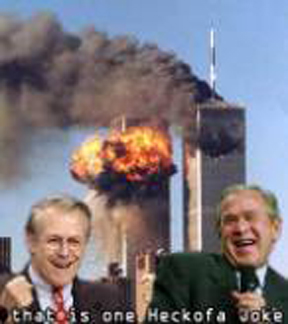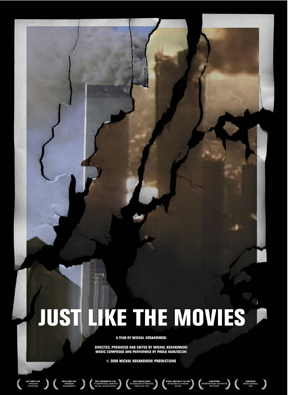Reconstruction 11.2 (2011)
Return to Contents»
Therapeutic Gaming and 9/11 / Joyce Goggin
Keywords: Culture Studies, Media, Visual Culture
<1> In 2003, a group of computer designers unveiled 9/11 Survivor, a video game MOD that they had created using the Unreal Game engine. This game, which places the player in the Twin Towers on September 11, 2001, boasts a story-line and gameplay that are rudimentary at best. The player’s avatar is almost invariably a businessman who is unable to find an escape route, so that the only choice players have is to perish by fire or plunge to their inevitable deaths [1].
 |
 |
| Screen shots from 9/11 Survivor | |
<2> One of the goals of the game was to immerse players in the terrifying surroundings of the burning skyscrapers, and to let them experience how it might have felt to be trapped inside the Twin Towers on 9/11. The interactivity of the game, and the realistic nature of the design environment, enabled the creators to emphasize the immediacy of this frightening moment in answer to the ostensible loss of immediacy and desensitization produced in the public through the constant repetition of iconic 9/11 images on CNN and other news networks.
<3> Only a few months after its release in 2003, the art collective that produced the game withdrew it from the Internet, allegedly because they received an $8,000 bill for heavy site traffic. However, the removal of 9/11 Survivor from the net was also motivated by death threats that the designers received along with public condemnation for bad taste and moral indecency. Those who sent death threats and criticism objected that the game trivialized the events of 9/11 by casting the attacks in an amusing light and inviting people to engage with the destruction and horror through digital play. They feared that making it possible for people to interact with the events of that day, “would challenge any notion of a unique configuration of ‘fact’ and ‘fixity’,” thereby reducing 9/11 to “the historically inconsistent and ludic” (Uricchio, quoted in Raessens 219). That the game had so few possible outcomes—essentially a number of ways to die or narrowly escape—also struck people as particularly macabre and not at all appropriate to the graveness of the tragedy and the extent of the devastation.
<4> I was introduced to 9/11 Survivor at the International Documentary Film Festival Amsterdam in 2005, where it was billed as a “docu-game” and presented along with other computer games classified as a form of documentary because they bear a resemblance to actual events, or because they have a political message of some sort. Such “reality” or “news gaming” supposedly immerses players in the action while permitting them to participate in events at which they were not present. These games equally challenge players to make choices with moral implications, ostensibly in the service of turning play into a “meaningful, interactive experience” (Raessens 216). While this recuperative theory of docu-gaming attempts to attach socially redeeming qualities to a cultural medium thought to encourage violence, sloth and addiction, the reaction of some audience members was to laugh out loud when the designers demonstrated the game. What followed was a remarkably heated debate about the notion of finding anything funny about the game at all; the tastelessness of the game; and the callousness of those who laughed.
<5> At the time, I was immediately reminded of Freud’s Jokes and Their Relation to the Unconscious, in which he investigates many aspects of humor and the mysteries of what we consider funny, including the kinds of bad jokes that invariably emerge following public catastrophe. These jokes, “that are constantly being newly produced in connection with the events of the day, are circulated anonymously” and perform a collective function that Freud likens to the “dream work,” namely the unconscious mechanisms whereby experiences—often painful—are recalled and revisited in a form rendered less horrific through mental processes (174). At other times, the “censorship of conscious thinking” keeps traumatic events repressed, which then “appear allowable (in jests) or sensible (in jokes), thanks to the ambiguity of words and the multiplicity of conceptual relations” (212-213). The replacement of an “objectionable element by one that is indifferent and that appears innocent to the censorship” permits a “small yield of pleasure” and the “avoidance of unpleasure” (212, 223). In this way, the unconscious allows us to work through feelings and thoughts that are otherwise repressed, such as taboo topics and memories that are too painful or difficult to face. The resulting pleasure constitutes a “cathetic expenditure” and may result in catharsis and possibly healing.
<6> In a similar vein, Frank Ankersmit has referred to 9/ll as an example of sublime rupture, or a dramatic event that provokes change, as the pleasant (the visual spectacle) and the terrible occur simultaneously (Raessens 222). The sublime experience, in this case of playing a computer game like 9/11 Survivor, has the potential to increase our understanding of traumatic events, because the moment of rupture that was 9/11 may be therapeutically reenacted.
<7> One of the many striking things about 9/11, however, is the hostile public response in many countries to any attempt to render the event psychologically manageable, such as 9/11 Survivor or bad jokes. On one website we read, “I hope you will understand my request and will not pass judgment on me, but it has been 5 years, and someone needs to break the barrier down. I am talking 9/11 jokes. I have searched and searched; yet, it’s futile. There are simply none out there” [2].
 |
From the site, http://www.ooze.com/articles/9-11-jokes.html |
While the author supplies the image above as a means of suggesting that some people may have found humour in the attacks on the Twin Trade Towers, he goes on to explain that, “[w]e assumed at the time that there would be plenty of terrible jokes to go around. When 9/11 jokes do pop-up they are either self-censored in some way (i.e. “I hope you will understand” as the same author apologizes above), or vaguely patriotic statements about killing Muslims. Are people so horribly offended by the events of 9/11 that they can’t make jokes? Was the death toll too high to mock? Was the destruction of American property too painful to bear?” (my italics).
<8> I would like to conclude by suggesting possible answers to these questions, and by responding to the notion that this tragedy, among countless much worse events in countries outside of the United States, has been inflated to such an extent as to eclipse all catastrophes, so that now we may only speak from a “post 9/11 world.” In light of the gravitas attributed to 9/11 as a global tragedy that everyone owns, rather than one of many—and one that specifically affected the U.S.A.—I would like to quote a famous statement made in 1969 by Pierre Elliott Trudeau, then Prime Minister of Canada, as he addressed the National Press Club in Washington, D.C. As he explained to reporters, “living next to [the United States] is like sleeping with an elephant. No matter how friendly and even-tempered is the beast, if I can call it that, one is affected by every twitch and grunt.” Trudeau’s observation helps to explain the magnitude that 9/11 is supposed to assume everywhere outside of the U.S., a country that allegedly rocks the world with its every move and waking thought.
<9> I would also like to suggest, along with countless others that, willfully or not, various media have kept the pain of 9/11 alive and real. This rupture of ruptures is like a wound that is kept open and exposed so that the healing process can never begin, hence the threat remains imminent, and the public remains traumatized. This indeed is the kind of pain that humor and games like 9/11 Survivor could help people to work through, if moral outrage and political maneuvering would die down long enough to give us a chance.
<10> There is another, somewhat more disturbing, conclusion that one might draw along with artist Michal Kosakowski, and cultural theorists like Žižek and Baudrillard. In one way or another, these commentators have asserted that, with 9/11, America finally got what it had been fantasizing about for years in innumerable Hollywood catastrophe films. In the first case, Kosakowski decided to take cultural theorists and many viewers of disaster movies at their word and, in 2006, he made Just like the Movies, a film that reconstructs the events of 9/11 entirely from clips taken from fifty-two, pre-2001 Hollywood films [3].
 |
The selected clips were edited together to produce a silent narrative that unfolds like most disaster movies, with blissfully unaware people waking up on a sunny day in New York City, just as they did on September 11, 2001. The fascination of Kosakowski’s film resides in its unsettling confirmation of Baudrillard’s claim that 9/11 was the fulfillment of a wish fantasy, which has obviously been “exorcised through images…drowning in special effects” (405). Hence, the absence of jokes about 9/11—jokes that might have had a therapeutic effect in helping us work through our purported global trauma—seems to support what Žižek and Baudrillard have claimed, and what Kosakowski to some extent demonstrated, namely that there was, strictly speaking, no real ostensible trauma from which to recover—at least no real global trauma. Therefore, as Žižek claimed, the Pentagon’s immediate and unconscious reaction to 9/11 was to summon “a group of Hollywood senarists and directors, specialists in catastrophe movies” in October of 2001 to help fight the war on terror, thereby proving that Hollywood functions as an “ideological state apparatus” (16). So for commentators like Baudrillard, Kosakowski and Žižek 9/11 was more of an event waiting to happen than it was a shock.
Works Cited
Ankersmth, Frank. Sublime Historical Experience. Palo Alto: Stanford University Press, 2005.
Baudrillard, Jean. L’esprit du terrorisme. Trans. Michel Valentin. The South Atlantic Quarterly 101.2 (2002): 403-415.
Freud, Sigmund. Jokes and their Relation to the Unconscious. Trans. James Strachey. New York and London: W.W. Norton & Company, 1989.
Goede, Marieke de. “Beyond Risk: Premediation and the Post-9/11 Security Imagination”. Security Dialogue 39 (2-3) 2008, 155-176.
Goux, Jean-Joseph. “Untimely Islam: September 11th and the Philosophies of History”. Trans. Doran, Robert and Caroline Vial. SubStance, Issue 115 (Volume 37, Number 1), 2008: 52-71.
Keane, Stephen. Disaster Movies: The Cinema of Catastrophe. London and New York: Wallflower, 2006.
Kosakowski, Michal. Just Like in the Movies. http://www.michalkosakowski.net/films/>. Accessed November 18, 2010.
Newman, Kim. Apocalypse Movies: End of the World Cinema. New York: St. Martin’s Press, 1999.
Raessens, Joost “Reality Play: Documentary Computer Games Beyond Fact and Fiction”. Popular Communication, 4 (3): 213-224.
9/11 Survivor. http://www.selectparks.net/911survivor.html
Žižek, Slavoj. Welcome to the Desert of the Real! Five Essays on September 11 and Related Dates. London and New York: Verso, 2002.
Return to Top»
